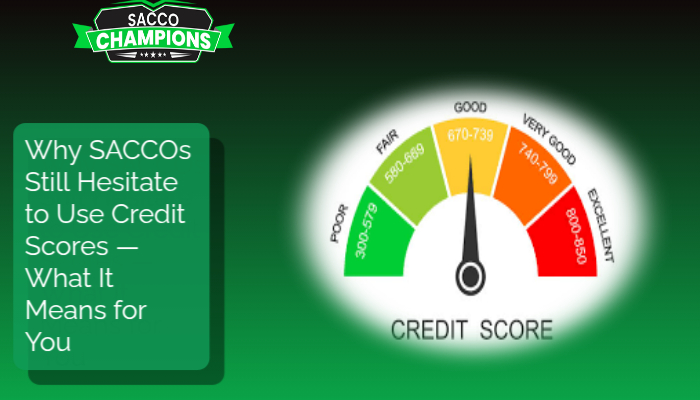This cautious stance influences how loans are approved, how members are evaluated, and how products are developed. If you’re part of a SACCO, understanding this hesitation helps you align your financial decisions with the future of cooperative lending.
Related: Product Development Review & Consultancy
Why Credit Scores Matter for SACCOs
A credit score reflects a borrower’s financial behavior and repayment history. For SACCOs, embracing credit scoring could transform their lending processes by:
-
Improving the accuracy of loan approvals
-
Reducing default risks
-
Promoting fairness and accountability
Globally, credit scores have empowered financial institutions to balance growth with stability. However, in Kenya’s cooperative movement, the pace of adoption remains slow.
1. Member Trust and the Human Factor
SACCOs thrive on relationships and community connections rather than algorithms. Loan officers often assess members through personal knowledge, contribution consistency, and savings history.
Many SACCO leaders worry that a purely digital approach might overlook the cooperative values that build trust. The fear of losing the “human touch” continues to slow down the transition to credit scoring.
2. Data Limitations and System Gaps
According to the SASRA 2024 Supervision Report, most SACCOs gather essential member data but lack integrated systems to analyze it effectively.
Without a centralized and secure data management infrastructure, credit scoring tools become unreliable. This gap limits the ability of SACCOs to make informed, data-driven lending decisions.
3. Cost of Implementation
Building a credit scoring framework involves more than just software installation. It demands investment in training, data management, and system maintenance.
For smaller SACCOs, such expenses can be overwhelming. Many prefer manual systems that seem cheaper and easier to manage—at least in the short term.
4. Regulatory and Compliance Concerns
While the Sacco Societies Regulatory Authority (SASRA) supports risk-based lending, many SACCOs still cling to traditional appraisal methods. The lack of clear data-sharing regulations and strong data protection policies has also made many institutions cautious.
Until Kenya’s cooperative sector achieves better regulatory clarity, SACCOs may continue to resist fully adopting automated scoring systems.
What It Means for You as a Member
If your SACCO still uses manual assessments, your savings record and guarantors will likely remain crucial for loan approval. However, SACCOs integrating credit scoring can process applications faster and offer more flexible loan options.
For members—especially younger borrowers—this shift means improved access to credit, personalized products, and reduced dependency on guarantors.
You may also like: Building Positive Workplace Culture Training
The Road Ahead for SACCOs
SASRA continues to encourage SACCOs to embrace digital transformation. As data systems advance and partnerships with credit reference bureaus grow, more SACCOs are expected to adopt hybrid lending models.
These models will blend human judgment with technology, maintaining the cooperative spirit while improving efficiency and fairness.
This evolution won’t erase the personal connection that defines SACCOs—it will simply enhance it with smarter decision-making and better risk management.
Conclusion
The hesitation to use credit scores reflects both respect for tradition and caution toward change. Yet, it also presents a powerful opportunity.
By integrating innovation into cooperative principles, SACCOs can preserve member trust while achieving financial sustainability.
As Kenya’s financial landscape evolves, one thing is certain—the future of SACCO lending lies in the balance between smart data and strong relationships.
For deeper insights into SACCO growth and transformation, visit Sacco Champions.
Enquire/Request Quote Here


